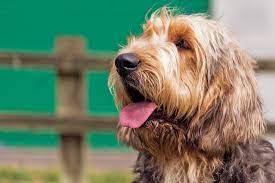Description: The Otterhound Terrier may be the largest terrier, with the dog measuring twenty two to twenty four in at the withers and about fifty five to seventy pounds. The bitch is somewhat smaller, being twenty two to twenty three in at the shoulder and getting a mass of forty to forty five pounds. The Otterhound Terrier has a square stand up, with much head as well as the tail is generally docked. The Otterhound features a double coat, with a tough guard coat over a fine, thick undercoat. The coat could be either tan and dark gray or grizzle and tan. This particular dog has a life span of ten to twelve years. The Otterhound is known as the King of Terriers or just Otterhound.
History: The Otterhound originated in the Otterhound Valley in Yorkshire, England. This was initially a dog on the working class and was developed by breeding small terriers, such as the Welsh Terrier, with the Otterhound to boost the dimensions of the dog. This larger dog was great at hunting larger game and was utilized also to offer protection to farms and houses. This particular breed done heroically during WWI in supplying emails and also in locating wounded soldiers so they might be evacuated to hospitals.
Temperament: The temperament on the Otterhound is the fact that of a good natured dog that likes being near its human family members. This's a playful and loyal dog that can occasionally be hard to teach due to its habit to clown around. While the Otterhound loves kids, it is usually a bit too rowdy for little ones. Early socialization is required if there are some other household pets, which dog's prey drive might never ever be eradicated around animals that are such as hamsters and guinea pigs.
Health Issues: The Otterhound could be governed by hip dysplasia. One more critical problem is bloat, which happens once the stomach twists & seals itself off. As nothing can move throughout the system, the dog is going to perish unless given veterinary attention quickly. Keeping the dog peaceful atmosphere after consuming, and also serving many small meals will often help. The skin of the dog could be subject to infection and irritation. The Otterhound also can experience eye issues including cataracts and progressive retinal atrophy.
Grooming: The layer on the Otterhound must be brushed the moment a week. Nevertheless, the thick undercoat must be stripped twice a season. This is often accomplished manually at home or by an experienced groomer. It's occasionally needed to cut away superfluous locks from between the forefoot. If the dog is running outside, it must be examined for ticks or maybe plant material which might have become lodged in the fur. Wash the muzzle after the dog has consumed.
Living Conditions: The Otterhound is a dog which has be near to the human family of its, it's been created as a dog that could meet up with people, and also it's not ideal for kennel life. As this particular dog is rather big and requires physical exercise, it's not a great dog for living in an apartment. The Otterhound is perfect in a home with a lawn. It must be offered a relatively lengthy walk each day for several of its physical exercise demands met by play together with the family.
For additional info on the Why Otterhounds Have Webbed Feet, Dog Training as well as Teacup Puppies on the market such as Morkies, Chihuahuas, and Yorkies please go to our sites below.

No comments:
Post a Comment